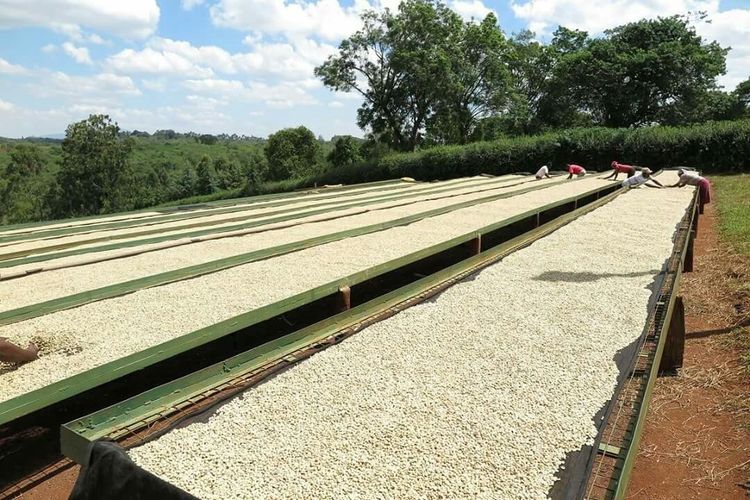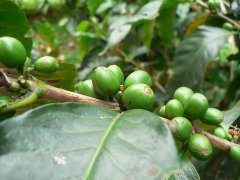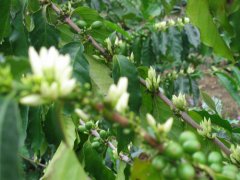African Kenyan coffee taste characteristics Kenyan sun treatment coffee beans flavor
Professional barista communication, please pay attention to coffee workshop (Weixin Official Accounts cafe_style)

Kenya Coffee Ndebes Solarization AA
Kenya Endebess Natural AA
Kenyan sun is less common on the market, probably because of the superior quality of Kenyan washing, coupled with the high loss rate of sun, and the high labor cost. In the past, Kenyan sun was only found in special custom programs of some American soybean manufacturers. Café Import's Ace project, for example, has produced several sun-baked French missionary bourbon. However, the quality has always been unsatisfactory, defective beans, flavor is not as rich as Ethiopian sun beans, but the price is better than Ninety Plus Tchembe.
This Kenyan batch is from bean dealer Y. Very rare, this batch of beans are Kenya's signature SL28 & SL 34. Because it's a long-term crop, the price is much more beautiful than the scarce French missionary Bourbon. SL28 and SL34 are still the main local production varieties, although the Kenyan government has recently actively promoted Ruiru varieties with stronger disease resistance and excellent quality. According to the green bean vendor, cup test flavors include tropical fruit, bright fruit acids, berries, and excellent cleanliness.
This time took 330g for testing, open the package can smell rich fermentation aroma, fermentation technology is quite good. But a pour out to see a diameter of 1.5 cm large stone. Even though the bean grower had warned them that foreign objects like fruit and cotton thread would cause some trouble, they were still scared by the stone.
100g of sample, excluding the big stone, defective beans accounted for about 8 g. Mostly broken, fruit, and shell beans.
Because of the small amount, into the bean temperature dropped to 150 degrees, temperature point fell at about 84 degrees, due to visual moisture content of about 10% of the new beans, heating rate is stable, about 12 minutes 45 seconds 200.8 degrees beans, after deducting the loss weight of about 282 g. After picking out the shells, it should lose another 8 g.
The dry nose has an integrated tropical fruit and some berry aromas, with a clear fruity nose at the beginning, accompanied by lemony sourness, and a rising juice sweetness and fruit wine fermentation at the end. Objectively speaking, it's a good bean, but it's a little bit defective. It's treated a bit like Central American sun, reminds me of last year's Eye of the Sun in Guatemala, and if the defective bean ratio improves, it'll be a great value coffee.
Important Notice :
前街咖啡 FrontStreet Coffee has moved to new addredd:
FrontStreet Coffee Address: 315,Donghua East Road,GuangZhou
Tel:020 38364473
- Prev

Evaluation of Coffee Sunshine Endebeth Coffee Raw Bean in Kenya AA
Professional baristas exchange please pay attention to the coffee workshop (Wechat official account cafe_style) Kenyan coffee Endaibeth sun treatment AA Kenya Endebess Natural AA insolation in Kenya is less common, perhaps because of the excellent quality of Kenyan water washing, coupled with the sun loss rate, the labor cost is too high, Kenya has been exposed in the past only in some of the United States
- Next

A comprehensive evaluation record of washed G1 Wonderland coffee beans which can best express the flavor of Yega Xuefei producing area.
Professional barista communication please pay attention to the coffee workshop (Wechat official account cafe_style) Ethiopian washing method Yega Xuefei G1 "Wonderland Paradise" Ethiopia Yirgacheffe village Gedeo Zone Washed G1 Paradise S teacher's beans have always been highly appraised on foreign coffee evaluation websites, and there are also items that have been drunk and bought in the past.
Related
- Detailed explanation of Jadeite planting Land in Panamanian Jadeite Manor introduction to the grading system of Jadeite competitive bidding, Red bid, Green bid and Rose Summer
- Story of Coffee planting in Brenka region of Costa Rica Stonehenge Manor anaerobic heavy honey treatment of flavor mouth
- What's on the barrel of Blue Mountain Coffee beans?
- Can American coffee also pull flowers? How to use hot American style to pull out a good-looking pattern?
- Can you make a cold extract with coffee beans? What is the right proportion for cold-extracted coffee formula?
- Indonesian PWN Gold Mandrine Coffee Origin Features Flavor How to Chong? Mandolin coffee is American.
- A brief introduction to the flavor characteristics of Brazilian yellow bourbon coffee beans
- What is the effect of different water quality on the flavor of cold-extracted coffee? What kind of water is best for brewing coffee?
- Why do you think of Rose Summer whenever you mention Panamanian coffee?
- Introduction to the characteristics of authentic blue mountain coffee bean producing areas? What is the CIB Coffee Authority in Jamaica?

